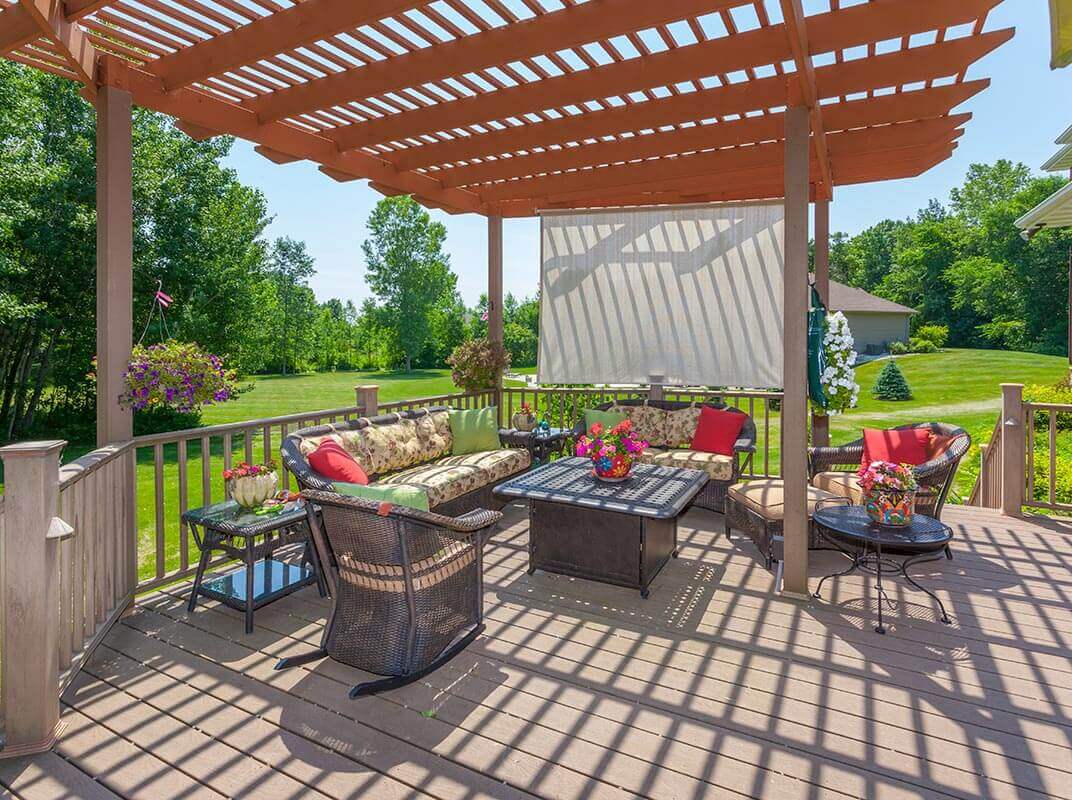
Looking for a relatively quick way to give your backyard a whole new look? Install a new patio cover. Patio covers can instantly change the entire feel of an outdoor space, all depending on your choice of style and materials.
But, what’s the best material for patio covers? It all comes down to your style, budget and the amount of time you can dedicate to maintenance.
Love the look of warm, traditional elegance? Go with wood.
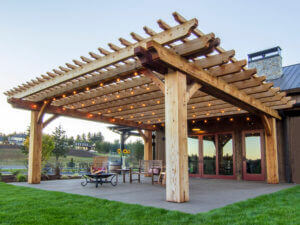
Wood patio covers are the most common for good reason. As a natural material, wood looks great and can be tailored to your style with paint or stain. Want a new look after a few years? No problem! Wood is easy to refinish by updating your paint color or stain.
Many species of wood work great for patio covers. Here are our recommendations:
Cedar
Western Red Cedar is an excellent material for a patio cover because it’s economical, attractive and resists moisture and pest damage. This is why Western Red Cedar is used in many outdoor applications, including decking, fencing and siding.
We also love Alaskan Yellow Cedar for many of the same reasons. This richly-colored golden wood resists damage from the elements but is still lightweight and soft enough to work with standard power tools.
Though both Western Red Cedar and Alaskan Yellow Cedar look great with a clear sealant, both accept stain and paint easily and evenly, making them a versatile choice for wood patio covers.
Redwood
Redwood’s durability, rich auburn color and naturally insect-resistant tannins make it another popular choice for outdoor applications. You’ll have the choice of sealing/staining the wood or leaving it exposed. If left untreated, the color of redwood will eventually fade into an attractive soft gray under the sun’s UV rays.
Douglas Fir
This exceptionally strong, medium-weight wood is an economical choice for your patio cover. However, Doulas fir will require more ongoing maintenance than other woods, so inspect your patio cover regularly, keeping an eye out for pest damage or rot. The natural knot and grain pattern of Doug fir creates an attractive, rustic look if left exposed and treated with a clear sealant, but this lumber also accepts stain and paint evenly.
Keep in mind that all wood patio covers require regular maintenance to protect the wood and increase longevity. You’ll need to monitor your wood patio cover regularly for pest or moisture damage.
Looking for something more modern? Canvas is the answer.
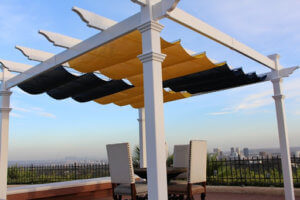 Canvas patio covers combined with a wood frame have exploded in popularity in recent years as more homeowners recognize the value of installing colorful, lightweight canvas canopies to cover their outdoor spaces. Canvas canopies create a fresh, breezy look with the added benefit of adjustability to permit your desired amount of sunlight.
Canvas patio covers combined with a wood frame have exploded in popularity in recent years as more homeowners recognize the value of installing colorful, lightweight canvas canopies to cover their outdoor spaces. Canvas canopies create a fresh, breezy look with the added benefit of adjustability to permit your desired amount of sunlight.
At J&W Lumber, we carry the Infinity Canopy which features adjustable, easy-slide design to allow shade or sun instantly. This straightforward system can be installed on free-standing or attached patio covers constructed from nearly any material. Infinity Patio Covers come in multiple colors and patterns, so they’re simple to swap as seasons – or personal tastes – change.
Want little to no maintenance? Try aluminum.
Aluminum patio covers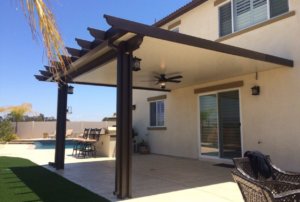 have come a long way in terms of design and durability. Aluminum patio covers are available in multiple color options and can mimic wood to deliver a crisp, modern look. They also stand up to sunlight and moisture exceptionally well, requiring minimal maintenance. That said, because of their lightweight metallic construction, aluminum patio covers are more susceptible to denting, and rain and falling debris from trees can be noisy.
have come a long way in terms of design and durability. Aluminum patio covers are available in multiple color options and can mimic wood to deliver a crisp, modern look. They also stand up to sunlight and moisture exceptionally well, requiring minimal maintenance. That said, because of their lightweight metallic construction, aluminum patio covers are more susceptible to denting, and rain and falling debris from trees can be noisy.
There are many choices when it comes to selecting the best material for your patio cover. Your decision will ultimately come down to your budget, personal style and future maintenance plan. As always, check your local city or county code before you begin construction to make sure the design for your patio cover conforms to all building requirements.
When you’re deciding on what type of patio cover material you want, the team at J&W Lumber is here to give advice, quotes or discuss pros and cons for each option.
After you’ve chosen your preferred patio cover material, you can either DIY it or hire a licensed contractor. Our team can connect you with preferred local contractors in your area.
If you’re ready to do it yourself, our team can assemble all the materials you’ll need (including hardware) and arrange for delivery to your home or easy pick-up at any of our Southern California J&W Lumber locations.
Ready to get started on your new patio cover? Contact us today and let’s get to work.
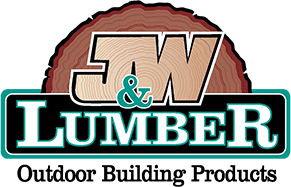
My wife and I have been planning to make upgrades to our home now that we’ve been earning more money. I really liked it when you brought up Cedar as an example of wood that’s pest and moisture resistant because we had planned to install new sections into the house and wanted to keep them as damage-resistant to as many things as possible. I’ll be sure to look for any lumber suppliers that we can call for our projects when we plan out more of our upgrades. Thank you!
Do these require a building permit if they are permanently attached to the house? I want to build a patio about 30′ wide × 52′ to 58′ long, and 11.5′ at the highest point without a center post/beam for my backyard so I can bbq all year long and have parties.